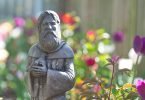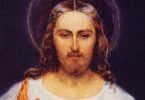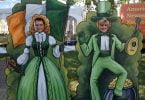
by Joe Bollig
Not entirely trusting my GPS, I was a little concerned about finding the new St. Gregory the Great Church in Marysville in time for the dedication on May 26.
I needn’t have been worried.
Coming up from the south on Highway 77, it was easy to see the 113-foot bell tower of the new church. Built on a rise, it reminded me of Matt. 5:14, “You are the light of the world. A city set on a mountain cannot be hidden.”
I’ve lost track of how many new church dedications and renovations I’ve seen in my time at “The Leaven,” but I’d have to say that St. Gregory Church is one of the best in the Archdiocese of Kansas City in Kansas.
Clearly, this is a parish that lavished a lot of love into building their church. If you appreciate traditional Catholic church architecture, this is a delight.
But there’s more at work here. What I find especially beautiful, and hopeful, is that this new church attests to the fact that the Catholics of Marysville know their own story.
They know their heritage. They know where they come from and where they are going. Their church is a symbol of their drawing strength from a deposit of faith, and their determination to pass on that deposit of faith generationally.
Sadly, too many Catholic families and individuals have lost their story. And losing their story meant losing their faith — losing Jesus.
I think it would be appropriate to say, in a certain sense, that our beautiful churches are sacramentals — those “objects or actions that the church uses after the manner of sacraments, in order to achieve through the merits of the faithful certain effects, mainly of a spiritual nature.”
That’s a mouthful, but it could be a simple as this: When a person sees that church, odds are they will think of God.
It’s also the kind of church that invites a person to come inside, check it out, and stay a while. Staying a while can lead to contemplating the holy symbolism throughout.
This is not to say that there’s anything wrong with simple churches. I like them, too. God can work anywhere, even in the starkest whitewashed auditorium.
But there is something that simply speaks true to a thing or place dedicated “holy to the Lord,” as in Zech 14:20.
That thing in our Catholic sensibilities that wants to dedicate a church — and that territory around the altar — as a place set aside for the most holy is our Hebrew DNA calling to us across the millennia from the Tabernacle tent of the Exodus and the Holy of Holies of the Jerusalem Temple. It proclaims that God presence is manifest here.
And in the calm dimness between Masses, the sanctuary candle burns as a silent sentinel before the presence of Jesus in Eucharistic form — “I am with you always, even to the end of the world,” Matt 28:20.
Christ is ascended to heaven, but we have not been abandoned. He has sent the Holy Spirit, and the Incarnation is continued in veiled form until “Before the day of the Lord comes, the great and terrible day,” Mal 3:23.







For many years while a student at St. Peter School in Newark, NJ, I served at that same high altar that St. Gregory the Great had installed in the new church. Our school was run by the School Sisters of Notre Dame. I graduated from the 8th grade in 1953 with highest honors and still have the fountain pen I received as an award. The pastor was The Right Reverend Monsignor Matthias A. Thimmes, M.R., V.F., P.A. It was a German parish that had deteriorated greatly. Then over a year ago, the church was demolished, much to my sadness. I am glad that the high altar was saved and restored.
Well done Joe Bollig, well done!!